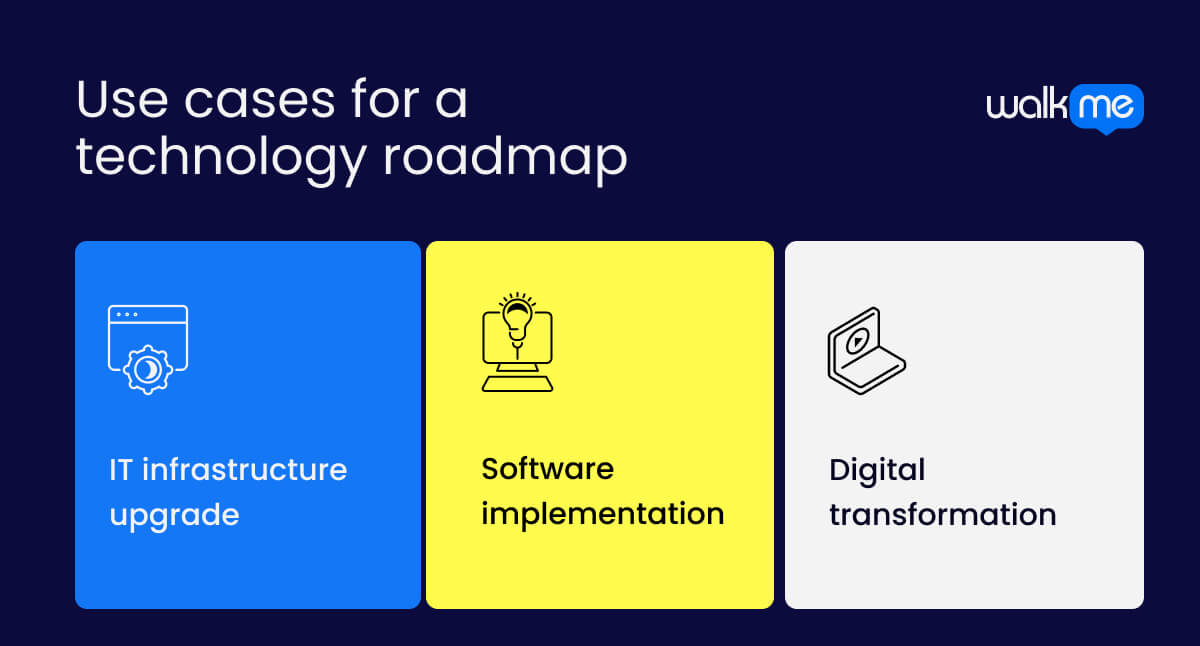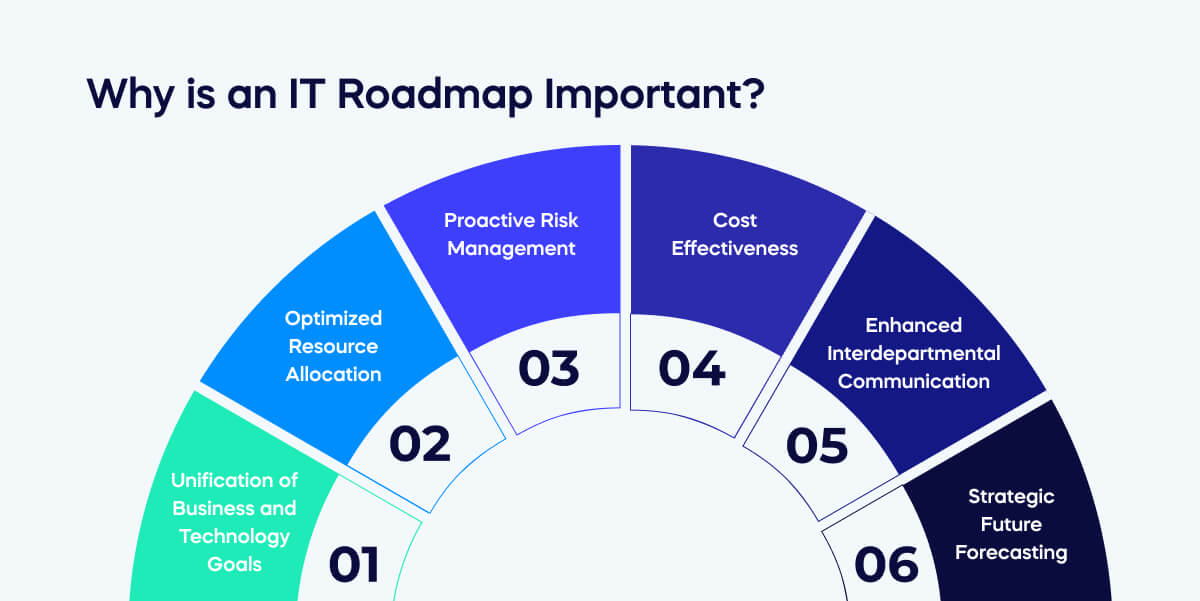Technology Roadmap

What is a technology roadmap?
A technology roadmap is a strategic planning tool that outlines how a company will adopt and utilize technology to meet its long-term and short-term goals. It provides a structured timeline that identifies key projects, milestones, and priorities, helping organizations coordinate resources and make informed technology decisions.
Technology roadmaps clarify when and how new technologies will be implemented, ensuring alignment with business objectives.
By breaking down initiatives into immediate, mid-term, and future tasks, roadmaps help leaders anticipate and plan for updates, manage resources efficiently, and avoid potential challenges.
A technology roadmap supports decision-makers in aligning technology initiatives with broader business strategies, enabling proactive management of technology investments.
What are the key components of a technology roadmap?

Technology roadmaps help research and development leaders show how technology projects align with business strategies, make resource decisions, and identify investment opportunities across the company.
By 2025, 80% of chief technology officers using technology roadmaps focused on business outcomes will see a 20% increase in employee and customer satisfaction due to better alignment of technology with business and customer needs.
Recognizing the key components of a technology roadmap clarifies how to set and achieve technology goals. These elements create a structured plan that guides project priorities, resource allocation, and strategic decisions, helping teams stay focused and aligned with business outcomes.
Goals and objectives
The technology roadmap begins with clear goals and objectives, outlining what the company aims to achieve with technology, such as streamlining processes or developing new products. These goals provide direction and align the team toward shared success.
Initiatives and projects
The roadmap specifies projects that directly support the company’s goals, detailing what needs to be done—whether launching new software or updating systems. Clear projects improve team focus and collaboration.
Timelines
Timelines indicate when each project should start and end, helping the team manage time effectively and ensuring progress stays on track.
Milestones
Milestones mark significant achievements within projects, showing progress and motivating the team as they reach key points.
Resources
Resources include the people, budget, and tools necessary for project completion. Identifying these ensures teams have the support needed to stay on track.
Dependencies
Dependencies outline connections between projects, showing which tasks need to be completed before others. Understanding these helps avoid delays and manage changes smoothly.
Risks and challenges
The roadmap identifies potential risks, such as technical issues or budget overruns, allowing teams to anticipate and prepare for challenges.
Stakeholder input
Stakeholder feedback ensures the roadmap aligns with various needs and perspectives, fostering collaboration and enhancing project success.
Technology roadmap vs. product roadmap
A technology roadmap and a product roadmap are both important plans for a company, but they focus on different areas.
- A technology roadmap looks at how the company will use and improve all its technology.
- A product roadmap focuses on one specific product, explaining its features and how it will get better over time.
Let’s take a closer look at the differences between these two plans.
| Technology roadmap | Product roadmap | |
| Definition | A plan that shows what a company wants to do with technology. It lists projects and their timing to help the company make good technology choices. | A plan that describes how a specific product will get better over time. It includes new features and when they will be available for customers. |
| Focus | All the technology the company uses, looking at different tools and systems that help the business succeed. | One product or a group of products. It is all about what customers want and how the product will change to meet those needs. |
| Techniques | Getting ideas from team members, tracking key steps, and managing resources. It often uses charts or pictures to show plans and links between projects. | Asking customers what they want and deciding which new features to work on first. It usually uses charts to organize the product features and when they will be ready. |
| Goals | Make sure technology projects help the company reach its goals and work better. It aims to keep technology useful and up-to-date. | Make a product that customers love, and that helps the company sell more. It focuses on improving the product based on what customers say and what is popular. |
| Examples of use | A company might use a technology roadmap to plan computer upgrades, add new software, or try new technologies to grow. | A technology company may create a product roadmap to show new features for a software program, plan when they will be ready, and decide which customer requests to work on next. |
Use cases for a technology roadmap

Technology roadmaps are useful in many business situations. They can help companies upgrade their IT systems, set up new software, or use digital tools to improve their work. Each situation below shows how a technology roadmap helps teams stay organized and focused on their goals.
IT infrastructure upgrade
A technology roadmap can show how a company plans to improve its technology. This means fixing things like computers, networks, and security to keep everything running well. The roadmap lists when each upgrade will happen and what new tools will be used.
By following this plan, the IT team can ensure that the company’s new technology is working smoothly. This helps workers do their jobs better and avoid problems that slow them down.
Software implementation
A technology roadmap can support software implementation by guiding a company through the steps required to adopt new software solutions, such as a customer management system or project management tool. The roadmap outlines essential actions, including training employees and providing ongoing support.
With a structured plan in place, employees can learn the new software efficiently, becoming more productive with it more quickly and enhancing overall operational effectiveness.
Digital transformation
A technology roadmap guides a company in adopting new technology for digital transformation, such as developing a mobile app or implementing cloud services. It outlines projects that modernize business operations.
This structured plan helps the company stay competitive and deliver improved customer service by leveraging innovative digital solutions.

What are the benefits of a technology roadmap?
A technology roadmap provides businesses with direction, enabling effective management of technology projects and resources. This approach promotes teamwork and informed decision-making, enhancing overall outcomes.
Here are the key benefits of implementing a technology roadmap in business.
Provides clear direction
A technology roadmap defines technology goals and project timelines, clarifying team roles and encouraging collaboration to achieve goals on schedule.
Improves communication
The roadmap enhances cross-team communication by offering a shared view of projects and timelines, leading to better teamwork and faster problem-solving.
Helps with resource management
It helps allocate resources by identifying tools, time, and personnel needed for each project, reducing last-minute issues and saving costs.
Supports better decision-making
With a clear view of long-term goals, leaders can make decisions aligned with future needs, adapting more easily to new technologies or market demands.
Encourages innovation
The roadmap inspires teams to propose new ideas and solutions, promoting innovation that enhances the company’s offerings and competitiveness.
Aligns technology with business goals
It ensures that technology projects directly support business objectives, making tech investments more purposeful and impactful.
Identifies risks early
Using a technology roadmap helps find possible problems before they happen. By laying out steps and timelines for each project, teams can see challenges before they get too big. Spotting these issues early gives the company time to make plans to fix these risks. Handling problems before they grow allows the company to keep projects moving forward and avoid delays.
Enhances accountability
By mapping out project steps and timelines, potential challenges can be spotted and addressed early, keeping projects on track.
What are the challenges of a technology roadmap?
Now let’s look at the challenges of creating a technology roadmap. By outlining clear goals and plans, businesses aim to manage their technology projects effectively.
However, there are several difficulties that can arise during this process, and understanding these challenges is crucial for success.
Unclear goals
One challenge is having unclear goals. If the company doesn’t know what it wants to achieve, planning can become difficult. Such confusion can waste time and resources, as teams may end up focusing on the wrong projects.
Resistance to change
Employees who may be comfortable with the old way of doing things may resist change, slowing progress and making it harder to follow the roadmap.
Lack of resources
Creating a technology roadmap needs time, money, and skilled workers. If a company lacks these resources, it can be tough to create and follow the roadmap, leading to incomplete projects or delays.
Changing technology landscape
The technology landscape changes quickly, making roadmaps outdated. New digital tools and trends emerge constantly, affecting the original plan. Companies need to stay flexible and adjust their roadmaps to keep up with these changes or risk falling behind.
How can DAPs help with a technology roadmap?
Digital adoption platforms (DAPs) can help make a technology roadmap easier to follow. They give businesses tools and guides to use new technology the right way. This helps teams learn quickly, stay on track, and reach their goals.
Let’s look at how DAPs can make a technology roadmap work better for businesses.
Streamlined onboarding
Digital adoption platforms make learning new technology easy and fun. They give step-by-step guides and interactive walkthroughs to help users learn how to use the tools. With clear instructions, teams can learn quickly and feel good about their skills. As a result, they can start using the technology right away and do their jobs better.
Continuous learning
There are resources and training materials for learning anytime. Users can find lessons, videos, and helpful tips whenever they want. Having easy access to this information helps everyone learn about new features and stay up to date. Because of this, teams can adjust to changes in technology and follow their plans more easily.
Enhanced user engagement
Digital adoption platforms make learning enjoyable for everyone by creating a fun experience. Users get helpful tips and real-time feedback while using the tools, making learning exciting. When employees have fun learning, they are more likely to use new technologies and stick to their plans, which helps the company do well.
Data-driven insights
These platforms share important information about how users act and learn. By watching how people use the tools, companies can see where users might need more help. Such insights help businesses change their plans and give support where it is needed most, leading to better results for everyone.